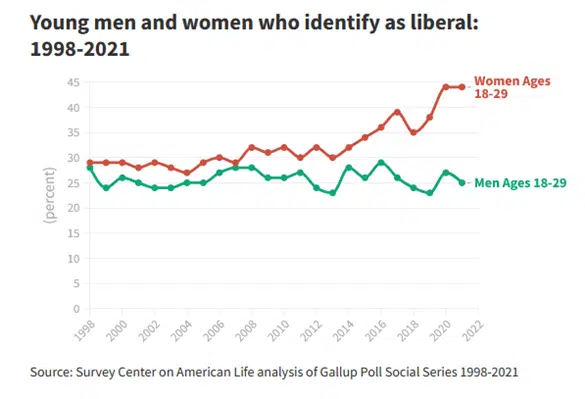
By Bill Wilson
A favorite argument the left propagates is that demographics are destiny, and that a tidal wave of young left-wing voters will erode GOP margins beyond repair. The argument that demographics are destiny is of course inescapable, but the argument that these demographics favor the left exclusively is misleading.
What the data shows is there have been small but discernible shifts away from the Democrat Party over the past few years. The bulk of the research on younger voters also shows a widening gender gap. Younger women are becoming increasingly liberal and younger men are not. Recent research shows that younger men hold more conservative views than older men on gender issues, including the transgender question.
While it is true that young people as a group favored Democrats at higher rates than older voters, they decreased support for Democrats compared to the 2018 midterms.
Democrats lost four points with voters under thirty between 2018 and 2022. Exit polls show Democrats won 63% of under thirties in 2022 while the GOP won 35%. However, four years ago Democrats won under thirties 67% to 32%, indicating a 4-point shift away from the Democrat Party for under thirties.
When breaking out the under thirty voting block into Gen Z (eighteen to twenty-four) and young Millennials (twenty-five to twenty-nine) the loss for Democrats is even more evident.
Democrats lost seven-points with the youngest eligible voters between 2018 and 2022. Exit polls show Democrats won 61% of Gen Z voters in 2022, down from 68% in 2018. The GOP gained five points with Zoomers, going from 31% in 2018 to 36% in 2022. The remaining Democrat losses may have gone third party.
The Market Research Foundation and Americans for Limited Government Foundation were some of the first and only research groups to point out in the 2018 midterms that very young voters in states like Florida, Georgia, Texas and Indiana voted GOP at higher rates than older peers. In several races, including in the Florida Governor’s race, Zoomers voted GOP at the highest rates of any age group under forty.
Our 2018 study of 1,500 members of Gen Z who were in middle school, high school and college at the time found unwavering support for an America First agenda, non-interventionist foreign policy, and the rule of law, particularly on the border.
Many of these young people are now eligible to vote, and while a substantial number of Zoomers supported Democrats in 2022, we are continuing to see a theme of the youngest eligible voters favoring Republican candidates at higher rates.
In the Wisconsin Senate Race last year, Ron Johnson won re-election with support from 36% of eighteen- to twenty-four-year-olds, compared to just 24% of twenty-four- to twenty-nine-year-olds. While this is by no means a blow-out victory for Johnson, it represents a 12-point difference between very young voters and slightly older voters. This wide variance calls for further research.
In Florida last year, while DeSantis performed well with young people overall compared to past years, his strongest support came from the eighteen to twenty-four-year-old age group. Gen Z supported DeSantis by 3-points more than twenty-five- to twenty-nine-year-olds. Compared to 2018, Zoomers supported DeSantis four points higher in 2022.
In the Michigan Governor’s race, young people voted overwhelmingly Democrat, but voters in the eighteen to twenty-four-year-old cohort supported GOP candidate Tudor Dixon by five-points more than twenty-five to twenty-nine-year-olds did. In fact, Zoomers supported GOP newcomer Tudor Dixon at the highest rate of any age group under forty.
Millennials and Gen X voters also shifted to the right in the 2022 general election. Democrats lost 5 points with voters thirty to thirty-nine, going from 59% in 2018 to 54% in 2022. Democrats also lost voters forty to forty-nine outright after winning them by narrowly in 2018.
While the mainstream media trumpets their victories with young people, they are ignoring the rightward trajectory of young voters in favor of a snapshot in time.
In addition, exit polls rarely break out younger voters by age combined with gender, and are missing the stark political differences between young men and young women.
Young men remain significantly less liberal than young women, and a growing portion are rejecting the radical left’s gender ideology, even as Boomers continue to uphold it.
Richard Manning, president of Americans for Limited Government Research Foundation, noted, “When you look behind the numbers of demographics in America, the dominant narrative fails to accurately describe generational attitudinal changes.”
Gallup Polling shows forty-four percent of young women ages eighteen to twenty-nine identify as liberal, the highest number in two decades. However, only a quarter of young men identify as liberal. As shown below, the share of young men who consider themselves liberal has fluctuated over the past 25 years but is overall declining, while the share of young women who consider themselves liberal has steadily climbed.
Younger men are also rejecting cultural liberalism according to research out of the Southern Poverty Law Center – an organization that could never be accused of a conservative bias. The survey found nearly half of Democrat men (47%) under age 50 believe “gender ideology has corrupted American culture” while only 20% of Democrat men over age 50 agree.
Younger Democrats also take the position that the transgender movement is a threat to children, with 42% of younger Democrat men saying that the transgenderism is a threat to children and 40% saying it is “trying to indoctrinate children.”
There is a vast generational divide among Democrat men when it comes to views on radical feminism. While only 2% of Boomer liberal men agree that “feminism has done more harm than good”, nearly half (46%) of young male Democrats, say feminism has done more harm than good in its current state. The polling results indicate Democrat men under 50 now oppose feminism at slightly higher rates than Republican men over 50.
A Meredith College poll from 2022 also shows while Gen Z does hold more liberal positions on issues like abortion and LGBTQ+ issues young men hold significantly less liberal views than young women. Polling shows almost half of Gen Z voters want to expand abortion access, compared to just 29% of Millennials. However, that view is primarily driven by young women. Zoomer men are much less amenable to expanding abortion access than Gen Z women.
The Meredith College data also shows a significant share of Gen Z men hold a more traditional view of gender roles. Over 40% of young men said they prefer a male political leader while 35% of Gen Z women prefer a female political leader. Gen Z men preferred a male political leader at the highest rate of any age group. Professor David McLennan who directed the poll, said:
“The results from our work suggest there is a strong conservative element within Gen Z on policy issues…a shift to more traditional views among the male population.”
The mainstream left and right are both ignoring a glaring indicator that young men are not on board the woke train. While young men and women share similar concerns about economic issues, they diverge on gender and identity politics. This divergence has the potential to have a dramatic impact in future elections and could in just a few years become the dominate challenge in electoral politics.
Bill Wilson is the former president of Americans for Limited Government.







